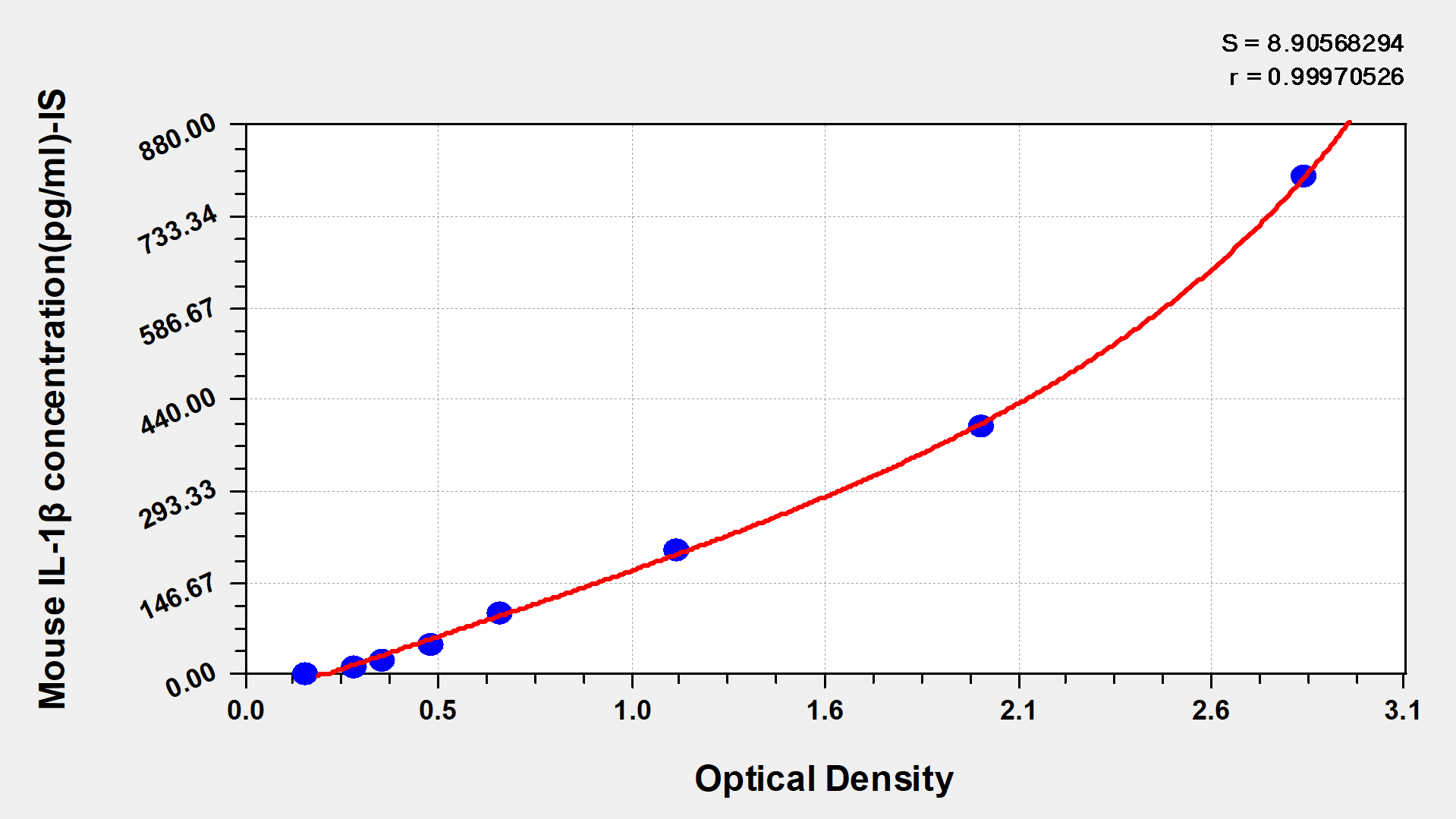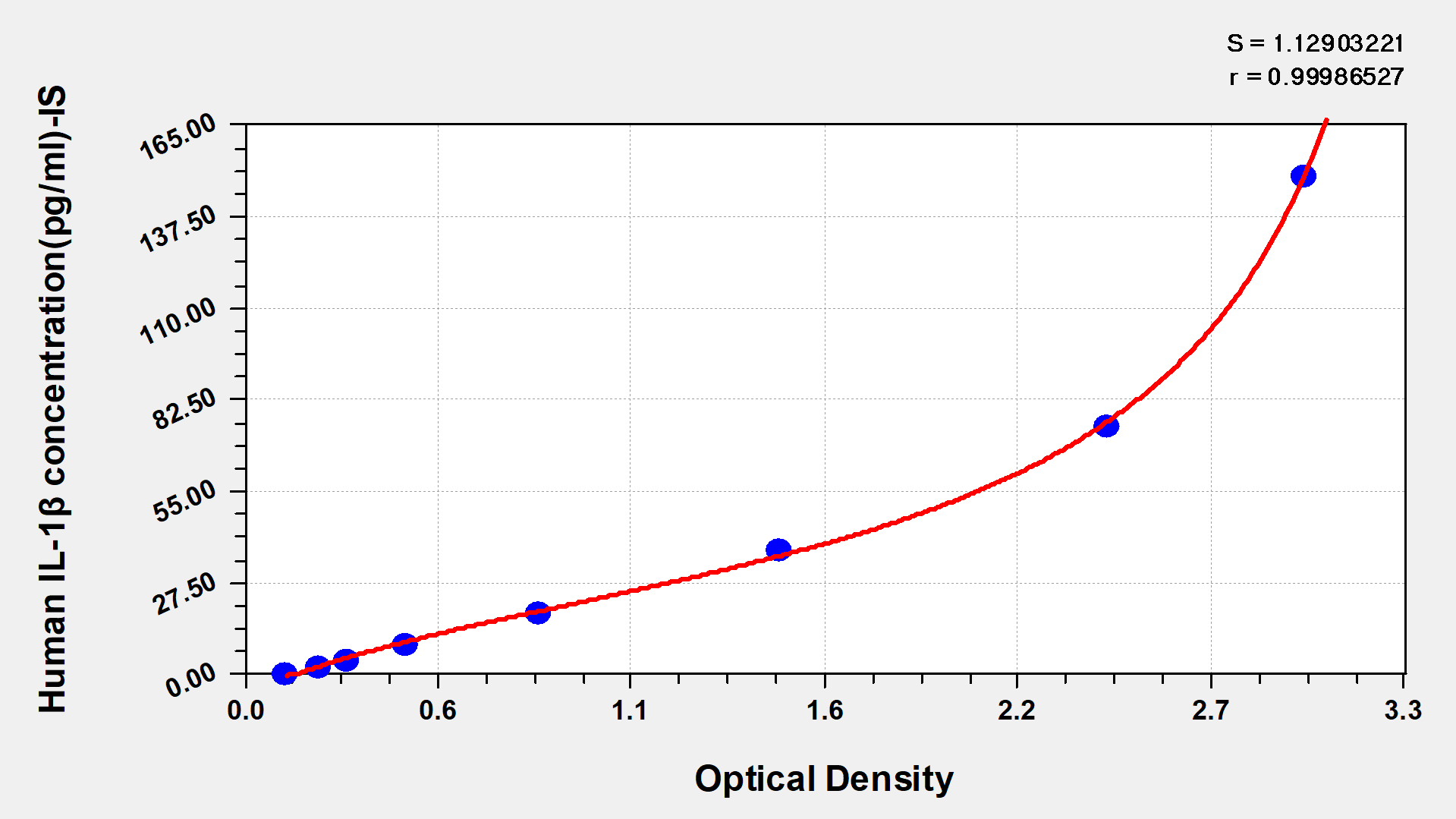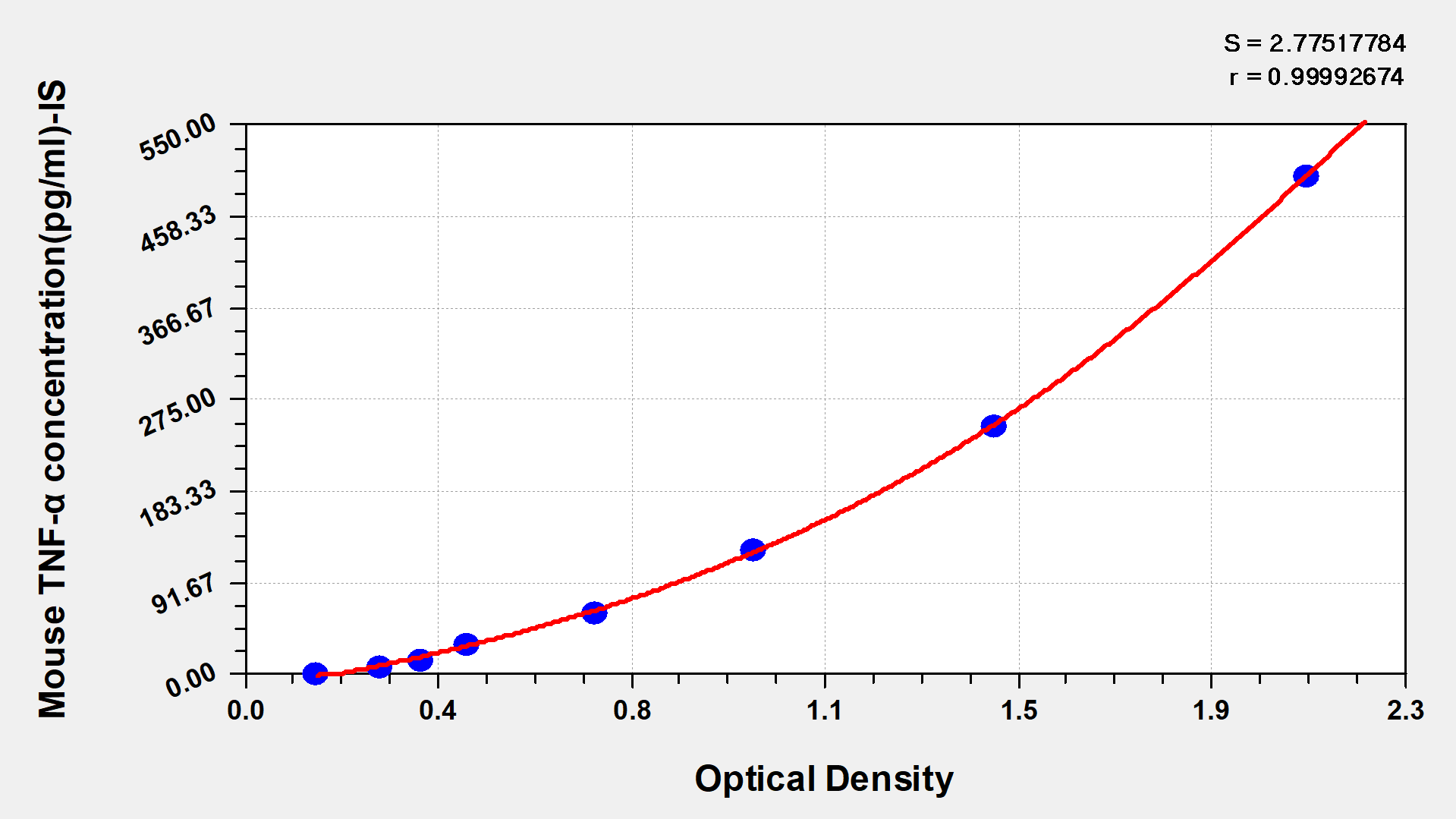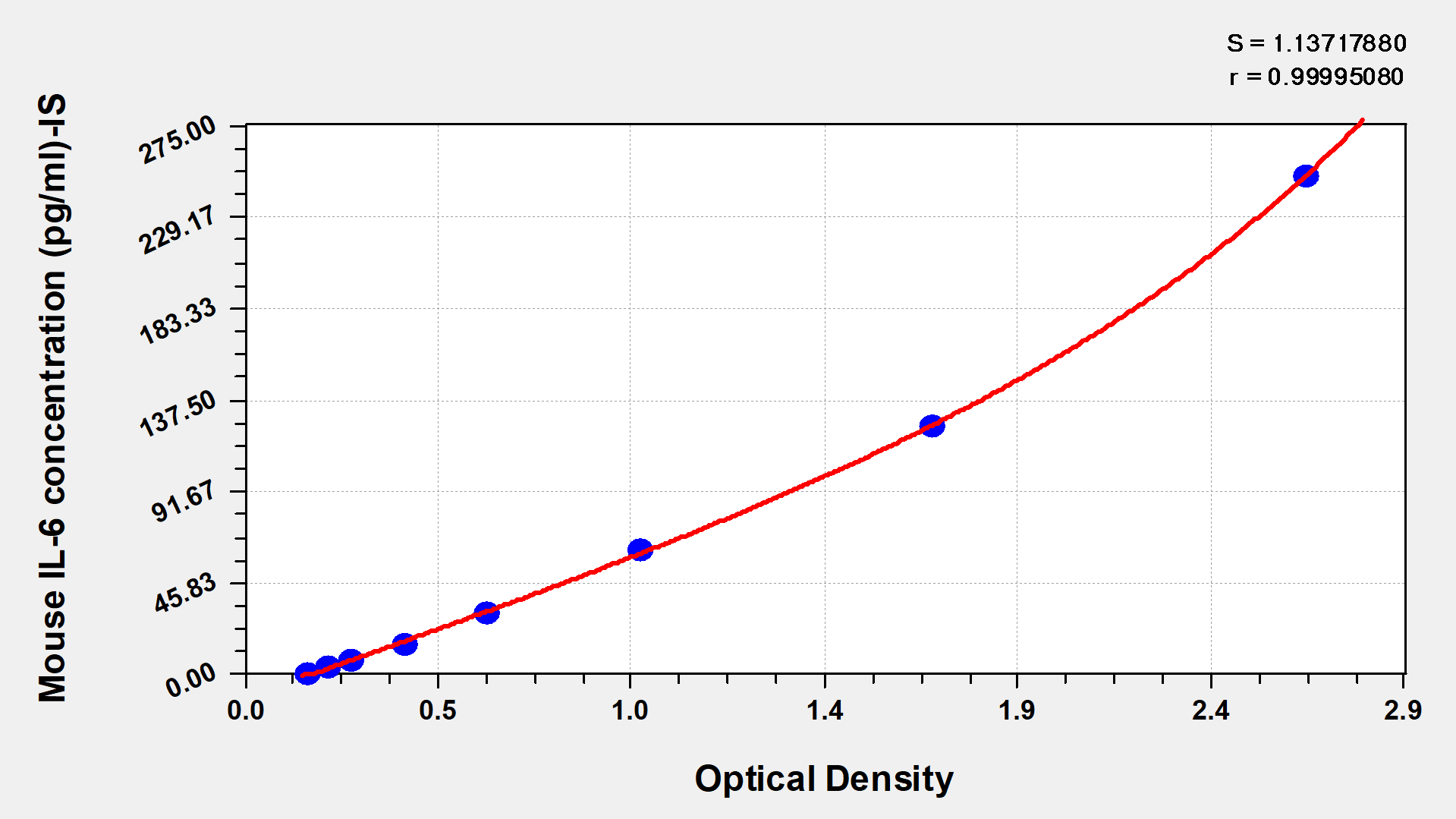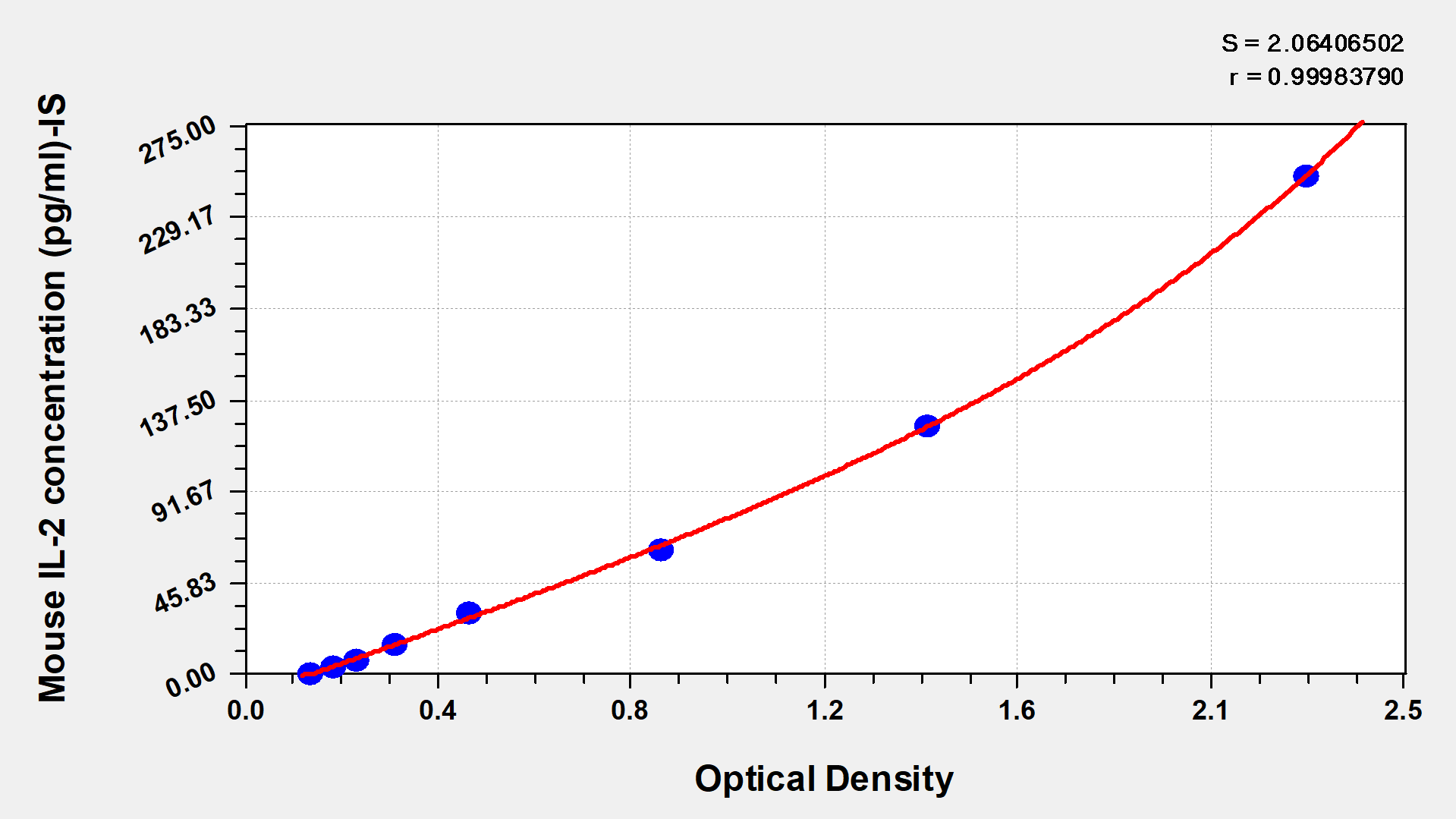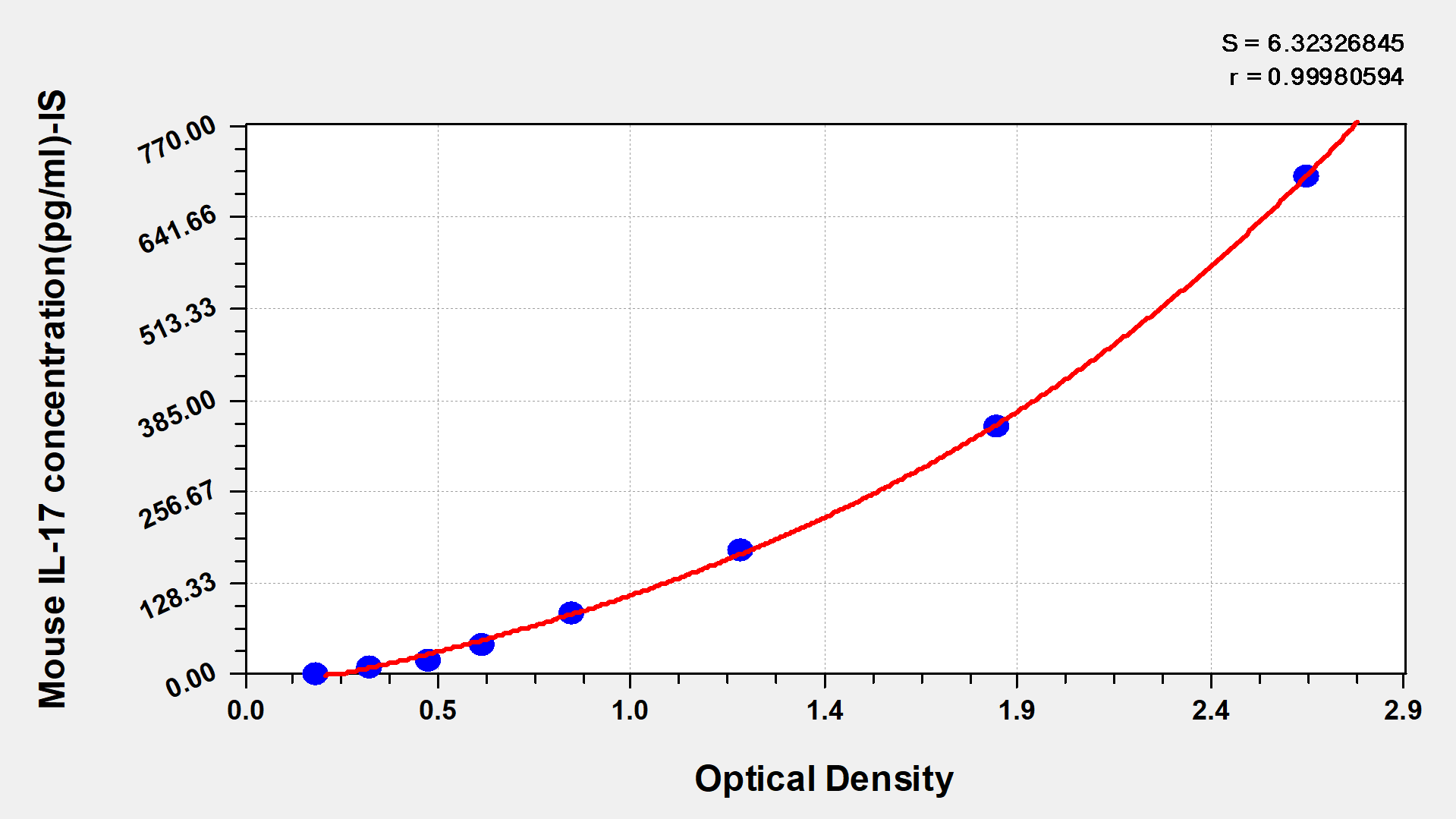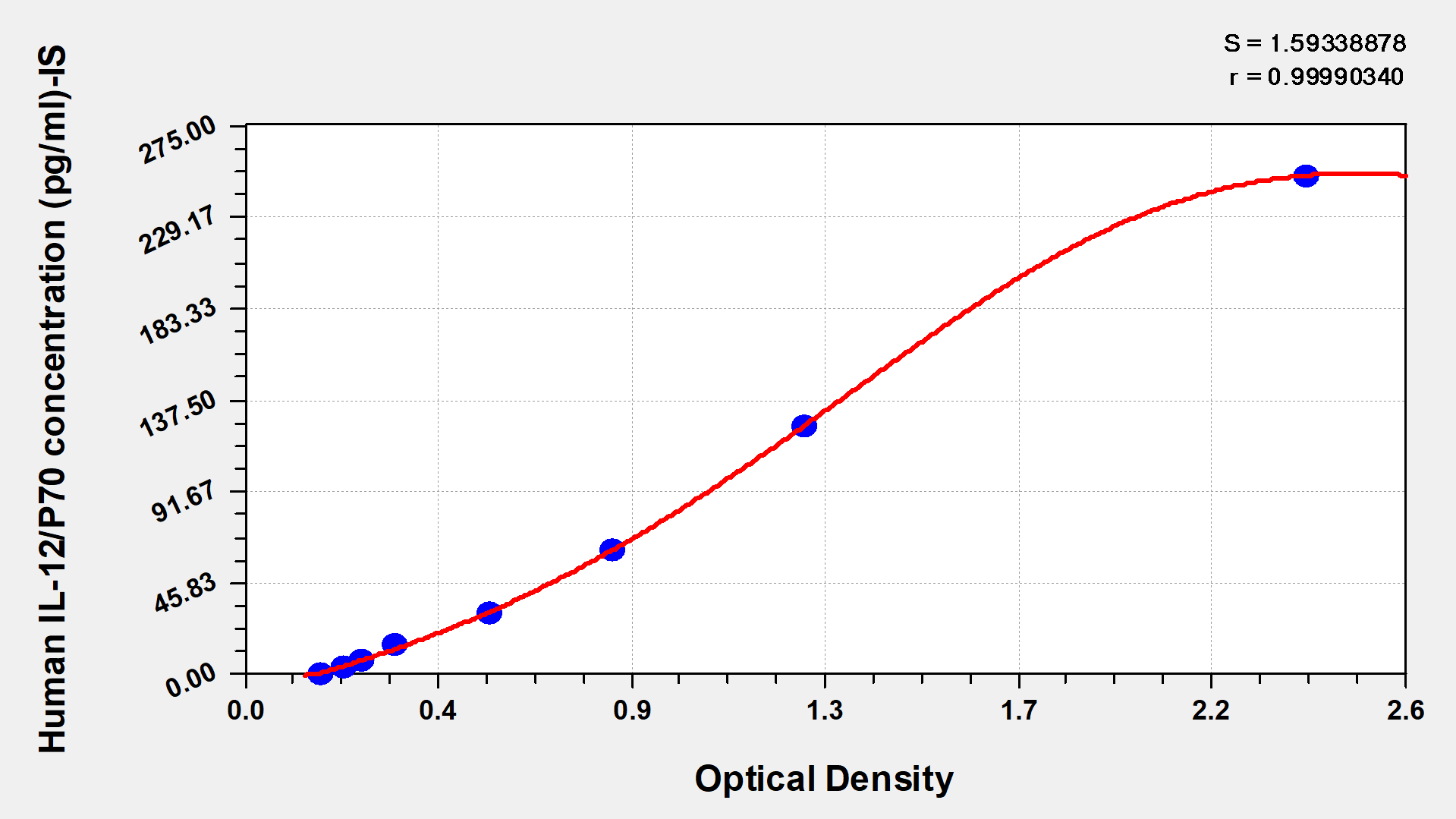Human intestinal fatty acid binding protein,iFABP ELISA Kit

產品詳情
-
產品描述:
人腸脂肪酸結合蛋白(iFABP)酶聯(lián)免疫試劑盒(CSB-E08024h)為雙抗夾心法ELISA試劑盒,定量檢測血清���、血漿、組織勻漿樣本中的FABP2含量。FABP2即脂肪酸結合蛋白2,主要在小腸表達����。它參與長鏈脂肪酸攝取����、轉運和代謝調節(jié)���。相關研究圍繞其結合脂肪酸的機制�����,以及在脂肪代謝異常����、胰島素抵抗等疾病發(fā)生發(fā)展中的作用展開�,有望成為代謝相關疾病治療的潛在靶點。試劑盒檢測范圍為0.156 ng/mL-10 ng/mL��,靈敏度為0.039 ng/mL??蒲腥藛T可通過定量評估腸道疾病模型(如小鼠腸缺血再灌注、細胞損傷實驗)中iFABP的動態(tài)變化���,或用于探究藥物��、營養(yǎng)素對腸道屏障功能的調控作用���,為腸道病理機制研究及干預策略開發(fā)提供數(shù)據支持。本品僅用于科研���,不用于臨床診斷�����,產品具體參數(shù)及操作步驟詳見產品說明書��。
-
別名:
FABP 2 ELISA Kit; FABP2 ELISA Kit; FABPI ELISA Kit; FABPI_HUMAN ELISA Kit; Fatty acid binding protein 2 intestinal ELISA Kit; Fatty acid binding protein ELISA Kit; Fatty acid binding protein intestinal ELISA Kit; Fatty acid-binding protein 2 ELISA Kit; Fatty acid-binding protein ELISA Kit; I FABP ELISA Kit; I-FABP ELISA Kit; IFABP ELISA Kit; intestinal ELISA Kit; intestinal FABP ELISA Kit; Intestinal fatty acid binding protein 2 ELISA Kit; Intestinal-type fatty acid-binding protein ELISA Kit; MGC133132 ELISA Kit; OTTHUMP00000163925 ELISA Kit
-
縮寫:
-
Uniprot No.:
-
種屬:
Homo sapiens (Human)
-
樣本類型:
serum, plasma, tissue homogenates
-
檢測范圍:
0.156 ng/mL-10 ng/mL
-
靈敏度:
0.039 ng/mL
-
反應時間:
1-5h
-
樣本體積:
50-100ul
-
檢測波長:
450 nm
-
研究領域:
Signal Transduction
-
測定原理:
quantitative
-
測定方法:
Sandwich
-
精密度:
Intra-assay Precision (Precision within an assay): CV%<8% | | | |
Three samples of known concentration were tested twenty times on one plate to assess. | |
Inter-assay Precision (Precision between assays): CV%<10% | | | |
Three samples of known concentration were tested in twenty assays to assess. | | |
-
線性度:
To assess the linearity of the assay, samples were spiked with high concentrations of human iFABP in various matrices and diluted with the Sample Diluent to produce samples with values within the dynamic range of the assay. |
|
| Sample | Serum(n=4) | |
1:1 | Average % | 94 | |
Range % | 85-105 | |
1:2 | Average % | 95 | |
Range % | 91-105 | |
1:4 | Average % | 99 | |
Range % | 92-107 | |
1:8 | Average % | 93 | |
Range % | 86-98 | |
-
回收率:
The recovery of human iFABP spiked to levels throughout the range of the assay in various matrices was evaluated. Samples were diluted prior to assay as directed in the Sample Preparation section. |
|
Sample Type | Average % Recovery | Range | |
Serum (n=5) | 95 | 89-103 | |
EDTA plasma (n=4) | 99 | 90-108 | |
-
標準曲線:
These standard curves are provided for demonstration only. A standard curve should be generated for each set of samples assayed. |
|
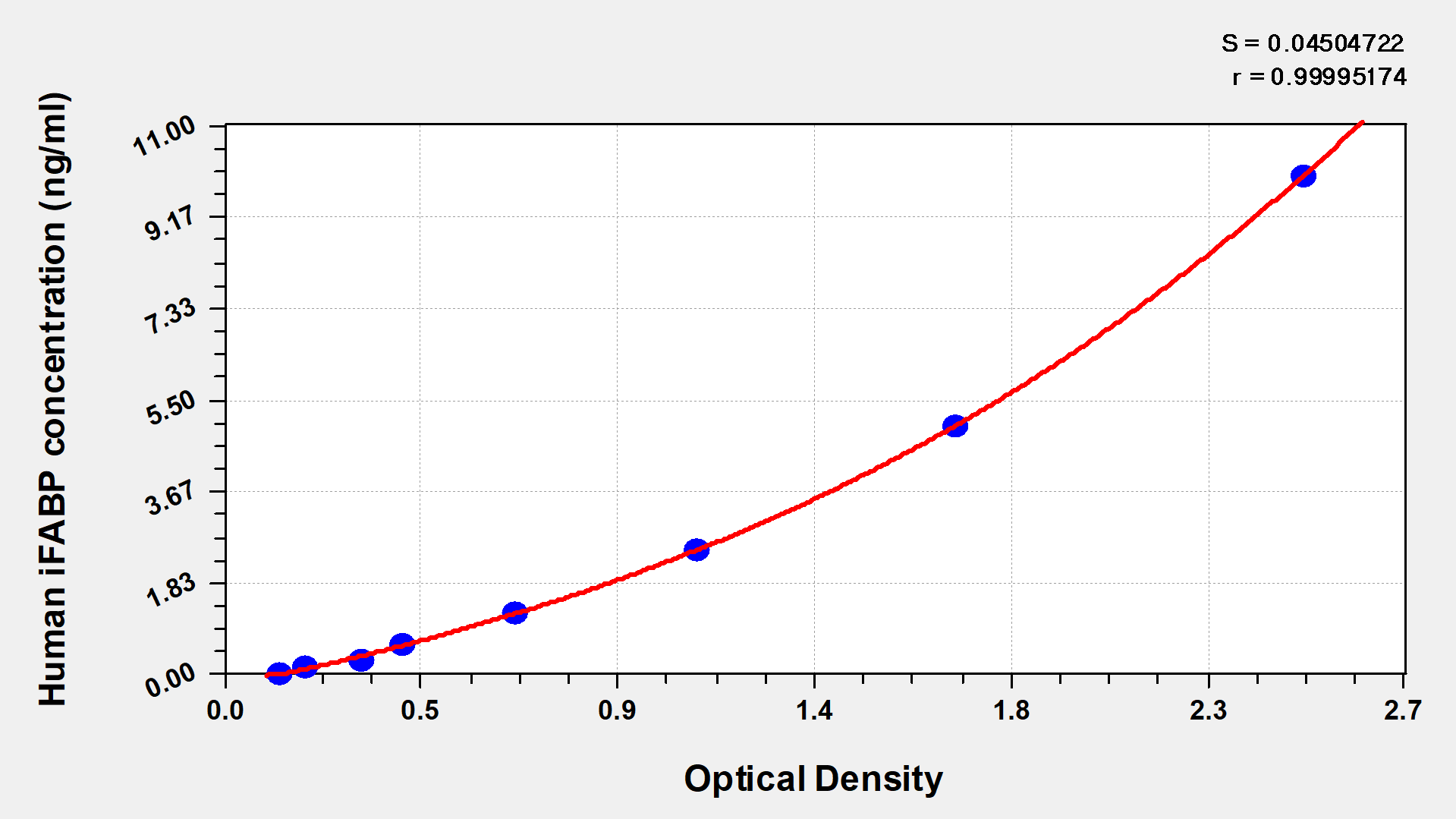
| | | | | | |
ng/ml | OD1 | OD2 | Average | Corrected | |
10 | 2.412 | 2.534 | 2.473 | 2.335 | |
5 | 1.695 | 1.667 | 1.681 | 1.543 | |
2.5 | 1.117 | 1.068 | 1.093 | 0.955 | |
1.25 | 0.696 | 0.659 | 0.677 | 0.539 | |
0.625 | 0.419 | 0.421 | 0.420 | 0.282 | |
0.312 | 0.320 | 0.333 | 0.326 | 0.189 | |
0.156 | 0.202 | 0.194 | 0.198 | 0.060 | |
0 | 0.141 | 0.135 | 0.138 | | |
-
本試劑盒所含材料:
- A micro ELISA plate ---The 96-well plate has been pre-coated with an anti-human FABP2 antibody. This dismountable microplate can be divided into 12 x 8 strip plates.
- Two vials lyophilized standard ---Dilute a bottle of the standard at dilution series, read the OD values, and then draw a standard curve.
- One vial Biotin-labeled FABP2 antibody (100 x concentrate) (120 μl/bottle) ---Act as the detection antibody.
- One vial HRP-avidin (100 x concentrate) (120 μl/bottle) ---Bind to the detection antibody and react with the TMB substrate to make the solution chromogenic.
- One vial Biotin-antibody Diluent (15 ml/bottle) ---Dilute the Biotin-antibody.
- One vial HRP-avidin Diluent (15 ml/bottle) ---Dilute the HRP-avidin solution.
- One vial Sample Diluent (50 ml/bottle)---Dilute the sample to an appropriate concentration.
- One vial Wash Buffer (25 x concentrate) (20 ml/bottle) ---Wash away unbound or free substances.
- One vial TMB Substrate (10 ml/bottle) ---Act as the chromogenic agent. TMB interacts with HRP, eliciting the solution turns blue.
- One vial Stop Solution (10 ml/bottle) ---Stop the color reaction. The solution color immediately turns from blue to yellow.
- Four Adhesive Strips (For 96 wells) --- Cover the microplate when incubation.
- An instruction manual
顯示更多
收起更多
-
本試劑盒不含材料:
- A microplate reader capable of measuring absorbance at 450 nm, with the correction wavelength set at 540 nm or 570 nm.
- An incubator can provide stable incubation conditions up to 37°C±5°C.
- Centrifuge
- Vortex
- Squirt bottle, manifold dispenser, or automated microplate washer
- Absorbent paper for blotting the microtiter plate
- 50-300ul multi-channel micropipette
- Pipette tips
- Single-channel micropipette with different ranges
- 100ml and 500ml graduated cylinders
- Deionized or distilled water
- Timer
- Test tubes for dilution
顯示更多
收起更多
-
數(shù)據處理:
-
貨期:
3-5 working days
引用文獻
-
Mucosal‐associated invariant T cells correlate with myocardial ischaemia and remodelling in coronary artery disease
J Wang, S Li, X Zhou, H Wu, X Ouyang,Clinical & Translational Immunology,2025
-
Neutrophil extracellular traps aggravate intestinal epithelial necroptosis in ischaemia–reperfusion by regulating TLR4/RIPK3/FUNDC1‐required mitophagy
C Chu,Cell proliferation,2023
-
Potential for CCR9+ IL-17+ Regulatory T Cell as a Predictor of Early Necrotizing Enterocolitis
F Li,Neonatology,2023
-
The Clinical Significance of Serum Biomarkers of the Intestinal Barrier in Systemic Sclerosis: A Cross-Sectional Study
A Stec,Journal of Personalized Medicine,2023
-
Association of intestinal and systemic inflammatory biomarkers with immune reconstitution in HIV+ patients on ART
M del Rocio Ruiz-Brise?o,Journal of Inflammation,2020
-
Increased ileal bile acid binding protein and galectin-9 are associated with mild cognitive impairment and Alzheimer's disease
Wang X, et al,Journal of Psychiatric Research,2019
-
The liver and small intestine can partly compensate severe normovolemic hemodilution in a rat model
Indra Naemi Waack .et al,Journal of Surgical Research,2018
-
Maraviroc Reduces Arterial Stiffness in PI-Treated HIV-infected Patients
Piconi S.et al,Sci Rep.,2016
-
Raised Venous Lactate and Markers of Intestinal Translocation Are Associated With Mortality Among In-Patients With HIV-Associated TB in Rural South Africa.
Subbarao S.et al,J Acquir Immune Defic Syndr.,2015
-
Association of plasma diamine oxidase and intestinal fatty acid-binding protein with severity of disease in patient with heat stroke
Zhang L.et al,Am J Emerg Med.,2015
-
Upregulation of inflammasome activity and increased gut permeability are associated with obesity in children and adolescents
Rainone V.et al,Int J Obes (Lond).,2016
-
Multiple inflammasome complexes are activated in autistic spectrum disorders
Saresella M.et al,Brain Behav Immun.,2016
-
Association of Plasma DAO and iFABP with Severity of Disease In Patient with Heat Stroke
Lin Zhang et al,The American Journal of Emergency Medicine,2015
-
Raised venous lactate and markers of intestinal translocation are associated with mortality amongst in-patients with HIV-associated TB in rural South Africa.
Subbarao S. et al,J Acquir Immune Defic Syndr,2015
靶點詳情
-
最新研究進展:
FABP2���,全稱脂肪酸結合蛋白2(Fatty Acid-Binding Protein 2),也稱為腸型脂肪酸結合蛋白(I-FABP)�,是一種小分子(約15kDa)的細胞內蛋白。FABP2主要在腸道內吸收和代謝脂肪酸時發(fā)揮作用�,它可以在腸道細胞內和血液中很快地轉運脂肪酸��,并通過運輸脂肪酸的過程參與脂質代謝和細胞能量代謝����。FABP2在心血管疾病����、代謝綜合征、炎癥和癌癥等多種疾病的發(fā)生和發(fā)展中具有重要作用���。最新研究表明�����,F(xiàn)ABP2可能與非酒精性脂肪性肝?。∟AFLD)的發(fā)生和發(fā)展有關���。一項研究發(fā)現(xiàn),F(xiàn)ABP2基因敲除小鼠的脂肪酸吸收和氧化能力降低����,這種轉化過程紊亂使得機體易于出現(xiàn)NAFLD。此外��,一些臨床研究也發(fā)現(xiàn),F(xiàn)ABP2與NAFLD的發(fā)生和嚴重程度呈正相關�。
-
功能:
FABP are thought to play a role in the intracellular transport of long-chain fatty acids and their acyl-CoA esters. FABP2 is probably involved in triglyceride-rich lipoprotein synthesis. Binds saturated long-chain fatty acids with a high affinity, but binds with a lower affinity to unsaturated long-chain fatty acids. FABP2 may also help maintain energy homeostasis by functioning as a lipid sensor.
-
基因功能參考文獻:
- Higher intestinal fatty acid binding protein (i-FABP) levels on admission were associated with pancreatic necrosis, systemic complications, and severe acute pancreatitis (AP). PMID: 29771764
- serum level in newborns positively correlated with second stage of labor duration and active pushing time PMID: 28110600
- We found that polymorphic Arg16Gly in the ADRB2 gene and Ala54Thr in the FABP2 gene had a discernible effect on the renal function in Chinese type 2 DN. Our data further revealed that homozygous Gly16 allele and Thr54 allele concomitantly conferred a significantly higher risk in the eGFR reduction. PMID: 29404926
- This study aimed to determine whether FABP2 (Ala54Thr) and MTTP (-493 G/T) genetic polymorphisms are associated with metabolic disorders in Mexican subjects. PMID: 29338565
- Data show that intestinal fatty acid binding protein (IFABP) is a promising prognostic marker in acute pancreatitis. PMID: 28984785
- There was a positive correlation between FABP2 levels and BMI, SBP and DBP, and a negative correlation with HDL-C. CONCLUSIONS: The Thr54 allele of the FABP2 Ala54Thr polymorphism was associated with an increased incidence of peripheral atherosclerosis combined with T2DM in the population studied PMID: 27778448
- The FABP-2 gene is located on the long arm of chromosome 4, and encodes an intracellular protein of the intestinal mucosa, responsible for the absorption and intracellular transport of fatty acids. PMID: 28760427
- Enterocyte injury was common in critically ill patients with pneumonia. The severity of enterocyte injury, as evidenced by the urinary FABP2/creatinine, was associated with the patient's mortality. PMID: 28164671
- Study reports that insulin resistance-related gene polymorphisms effects colorectal cancer (CRC) risk. The results showed that the gene polymorphism of ADIPOQ rs2241766 was associated with CRC risk. Furthermore, the interactions of ADIPOQ rs2241766, UCP2 rs659366, FABP2 rs1799883 and red meat consumption may contribute to the risk of CRC. PMID: 23826253
- FTO and FABP2 gene polymorphisms were significantly associated with susceptibility to metabolic syndrome and obesity in this cohort. PMID: 28738793
- Circulating I-FABP levels had no association with invasively-measured hemodynamic parameters, but were associated with adverse clinical outcomes in patients with acute decompensated heart failure with systolic dysfunction. PMID: 28232029
- The aim of this study was to measure serum I-FABP levels and provide the transition of I-FABP levels with hypothermic circulatory arrest to help in the management of intestinal perfusion. Plasma I-FABP monitoring could be a valuable method for finding an intestinal ischemia in patients with cardiovascular surgery. PMID: 27765895
- Urinary intestinal fatty acid-binding protein can distinguish necrotizing enterocolitis from sepsis in early stage of the disease. PMID: 27110575
- I-FABP is a valid serologic biomarker for early diagnosis in NEC for the premature neonates with a moderate accuracy. PMID: 26798632
- It is concluded that ACE (rs 4646994), FABP2 (rs1799883) and GST (GSTM1 null or positive genotype and GSTT1 null or positive genotype) genes polymorphism are associated with essential hypertension. PMID: 25357227
- Ala54Thr polymorphism of FABP2 modulates HDL cholesterol in Mexican-Americans with type 2 diabetes. PMID: 26703680
- Carriers of the Thr54 allele in FABP2 have a different metabolic response after weight loss than wild type non-A obese carriers PMID: 26316042
- Letter: serum intestinal-fatty acid binding protein may serve as a biomarker for refractory celiac disease. PMID: 26114190
- Ala54Thr polymorphism of FABP2 was associated with high triglycerides levels, but not to gallstone disease. PMID: 26019038
- FABP2 Ala54Thr polymorphism may have a role in type 2 diabetes, obesity, and metabolic syndrome [case-control study and meta-analysis] PMID: 25730055
- Both plasma and urinary I-FABP levels specifically identify necrotizing enterocolitis in preterm infants. PMID: 25793701
- FABP2 is a gene candidate for predisposition to Diabetic nephropathy, as it has been linked to microalbuminuria in patients with Type 2 Diabetes mellitus. PMID: 25594612
- To determine the allele/genotype frequencies of Ala54Thr polymorphism of the FABP2 gene. PMID: 26238699
- Increasing gestational age is accompanied by an increase in ileal I-FABP tissue content. PMID: 24956227
- Studies suggest that the fatty acid binding protein 2 (FABP2) Ala54Thr polymorphisms (rs1799883) are associated with increased susceptibility to type 2 diabetes mellitus risk (T2DM) risk among Asians but not Caucasians. PMID: 25388378
- ACE (I/D) and FABP2 (Ala54Thr) genes polymorphism and its susceptibility to type 2 diabetes mellitus in the North Indian population, was studied. PMID: 23468166
- Ala54Thr of FABP2 may be not associated with stroke risk but associated with plasma triglyceride level of stroke patients for Hunan Han population of China. PMID: 25262933
- systemic marker for Crohn disease activity PMID: 25807642
- The study suggests that the above named variant in FABP2 gene is not potential contributor to the risk of T2DM and related traits in a Saudi population. PMID: 24690233
- Systemic I-FABP levels appear valuable in detecting irreversible intestinal ischemia-reperfusion damage. PMID: 24100750
- the Ala54Thr fatty acid-binding protein 2 (FABP2) polymorphism may have a role in recurrent depression and is associated with fatty acid concentrations and waist circumference PMID: 24340071
- FABP2 Thr54 carriers have a better metabolic response than obese carriers with Ala54Ala genotype to high-polyunsaturated dietary fats. PMID: 23072901
- FABP2 gene Ala54Thr polymorphism is associated with the predisposition to physical endurance and is not associated with risk of obesity and body fat mass. PMID: 24640155
- INSR rs1366600, ACSL1 rs2292899 and FABP2 rs11724758 could influence the susceptibility to type 2 diabetes in Chinese Han population, most likely through their effects on the specific miRNA-binding sites. PMID: 23303383
- Carriers of Thr54 allele of FABP2 have a different response than wild type obese, with a lack of decrease of insulin levels, leptin levels and HOMA-Insulin resistance. PMID: 23817228
- Polymorphisms in FABP2 and APOL6, located at the predicted miRNAs binding sites, are identified to contribute to susceptibility to MetS in the Chinese Han population. PMID: 23911300
- results suggest that the higher cardiorespiratory fitness may attenuate the changes in central arterial stiffness and blood pressure that are associated with the FABP2 genotype PMID: 23362142
- Thr54 allele carriers responded better to a moderate-fat diet in overweight or obese subjects. PMID: 22817827
- Mutation frequency of FABP2 gene in the people with dyslipidemia was significantly higher than that in the people with normal blood lipids. PMID: 21861348
- FABP2 genetic polymorphism is associated with lower triglyceride and higher HDL-cholesterol concentrations in elderly subjects with MetS PMID: 22838187
- The Ala54Thr polymorphism in the FABP2 gene was not associated with obesity in the Chinese Han population of the Chengdu area. PMID: 21355293
- meta-analysis does not support the association between the FABP2 Ala54Thr polymorphism and body mass index PMID: 20621703
- We hypothesized that the triglyceride-rich lipoproteins response to diets of varied fat content is affected by the FABP2 A54T polymorphism....no evidence of an interaction, which does not support our hypothesis. PMID: 21840466
- The findings suggest a potential distinct role(s) of SNPs in FABP5 and FABP2 genes in T2DM in different populations. PMID: 21288588
- The finding of ths study was the lack of association of the Thr54/Ala54 and Thr54/Thr54 fatty acid binding protein 2 genotypes with metabolic syndrome. PMID: 20723947
- genetic association studies [Iran]: FABP2 SNP affects response to eicosapentaenoic acid supplementation in hypertriglyceridemia; more favorable effects on blood lipids/lipoproteins in subjects with Ala54/Thr54 genotype than with Ala54/Ala54 genotype PMID: 20080390
- FABP2 Thr54Thr genotype might increase the risk of non-alcoholic fatty liver disease. PMID: 19689066
- Thr54 allele of the FABP2 Ala54Thr is weakly associated with a higher degree of insulin resistance, higher level of fasting insulin and higher level of 2-h blood glucose. PMID: 20578207
- TT genotype in Ala54Thr polymorphism of FABP2 gene in patients with type 2 diabetes increased dietary fatty acid absorption, and this might increase the susceptibility to the effects of dietary lipids. PMID: 20484485
- data indicate that intestinal fatty acid binding protein (FABP2) expression depends on (n-3) fatty acid intake and FABP2 genotypes PMID: 20534879
顯示更多
收起更多
-
亞細胞定位:
Cytoplasm.
-
蛋白家族:
Calycin superfamily, Fatty-acid binding protein (FABP) family
-
組織特異性:
Expressed in the small intestine and at much lower levels in the large intestine. Highest expression levels in the jejunum.
-
數(shù)據庫鏈接:
Most popular with customers





